.....When I was learning how to play
pool there were no books, no videos, no instructors and no leagues
to play in. The best way to learn was to watch. I was privileged
to see some of the greatest and some of the not so great. My
purpose for publishing my pointers insrtuctional column is not
only to inpart pool knowledge to my viewers but to share with the
public what these great players from the 1980s and 1990s looked
like. Through my trusty Canon, for a moment in time they are immortalized.
Some are still here and some are gone and I still remember the
joy of watching them play.
DON'T LET YOUR DRAW STROKE BE A DRAWBACK
Loose Wrist; Cue Ball Zips 
IN POOL, there are different types of “strokes” a competitor must master in order to become a complete player. One of the last strokes a person learns is the art of drawing the cue ball. Above, you can see “Boston Shorty” approaches the very bottom of the cue ball before he implements a draw shot that propels the cue ball backwards, hits the rail and zooms the cue ball to the right and back to the foot of the table. Impressive.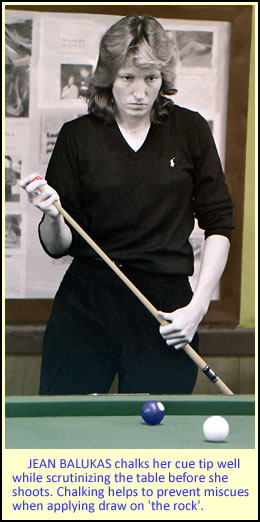
A draw shot is when, after contacting the object ball, the cue ball stops momentarily then moves backwards towards the player. Not only does it look good to the player him/herself, but it is a crowd pleaser. Everybody loves seeing the cue ball race backwards, especially if the act includes large distances. That is, if the object ball the cue ball draws off of is far away, say three or four diamond lengths between them; or if whitey is near the object ball and the player draws in reverse the length of the table. And it is particularly pleasing if the cue ball draws off a ball, hits the rail and then spins off in another direction on the draw stroke as Shorty did in the above photo.
Start by chalking up your cue, whether it's a house cue or your own cue. Don’t be stingy with the chalk; make sure you have a good coating over the top and around the sides. The danger in executing the draw stroke is that the player may “miscue”; meaning that the cue stick tip slides off rather than grips the cue ball. A good coating of chalk will prevent that from happening. In the meantime, take that opportunity to look around the table and plan your game strategy.
Although the technique for striking the cue ball may be different among various players, there are some common grounds. Get comfortable with your stance. Since you are about to strike the cue ball low, lower your bridge hand. Minimize the amount of elevation you put on the back of your cue stick. You’ll need a little tilt but not a lot. Here, Tommy Kennedy approaches the rock low and is still relatively level.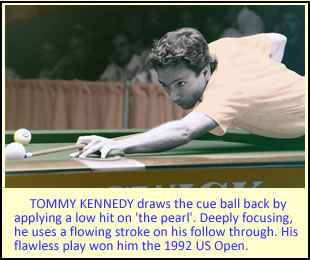
There are several important factors in accomplishing the draw action. Be sure to use a light hold on the cue stick. Don’t hold it in a death grip. Aim low and, as Abe Rosen used to say, ‘dig’ into the ball to acquire maximum spin. Don’t poke or use a short, quick stroke. You’ll need to gracefully follow through with a natural and effortless swing.
Usually, when a player strikes the cue ball in the center with a level cue and medium speed, the primary action of whitey is to slide a little and then become a forward roll. When one applies a downward stroke about 2 ½ tips or more below center with a smooth confident stroke the cue ball spins in reverse after contacting the object ball.
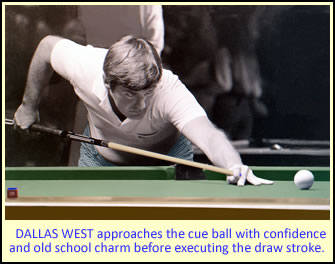 Observe how Dallas West pulls the cue tip all the way into his fingers on his draw back. This is a very “old school” approach to cue stroking techniques. I’ve only seen this type of cue stroking done by the old time players like Irving Crane, Jimmy Caras, UJ Puckett, Willie Mosconi, etc. It is yet to be decided whether or not it gives anything ‘extra’ to a players follow through. But, I digress… Observe how Dallas West pulls the cue tip all the way into his fingers on his draw back. This is a very “old school” approach to cue stroking techniques. I’ve only seen this type of cue stroking done by the old time players like Irving Crane, Jimmy Caras, UJ Puckett, Willie Mosconi, etc. It is yet to be decided whether or not it gives anything ‘extra’ to a players follow through. But, I digress…
When the cue ball is farther away from the object ball you’ll need to hit it lower, about three tips below center, and strike the pearl a bit harder to sustain the backward spin over a long distance. Be sure to keep that loose hold on the cue stick, as if you are throwing the stick at the cue ball. The best felt to get the utmost backspin on is Simonis cloth from Belgium which has no pills or fluff. If you are playing on another brand cloth, it may be a heavier weave and prevent you from getting the maximum backwards movement. In this case, the equipment may be a factor.
In order to 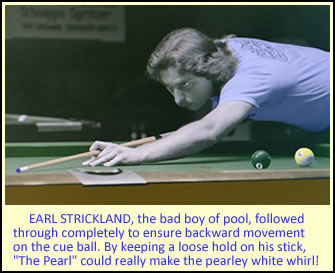 polish your draw stroke, you will need to practice it while you are not competing with someone else. In other words through practice drills. Set up the cue ball and an object ball about a diamond width apart and try to draw the cue ball back to where it started. Once you get a handle on that, move the balls two diamonds width apart and complete the same exercise. Continue to do drills and experiment with wider distances each time until you become a crackerjack at drawing the ball. polish your draw stroke, you will need to practice it while you are not competing with someone else. In other words through practice drills. Set up the cue ball and an object ball about a diamond width apart and try to draw the cue ball back to where it started. Once you get a handle on that, move the balls two diamonds width apart and complete the same exercise. Continue to do drills and experiment with wider distances each time until you become a crackerjack at drawing the ball.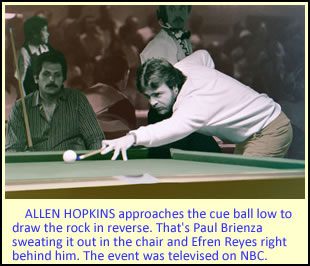
If you’d like to try the same effect that Larry "Boston Shorty" demonstrated, place the cue ball about six or seven inches from the rail and the object ball about a foot in front of it and straight with the pocket. Approach the cue ball similarly to the way that Allen Hopkins is in the picture (except you’ll be lined up straight). Now apply English (side spin) to the cue ball, at least one ½ tips, on the opposite side of the ball that you want to go. Strike on the right side to go left (or vice versa) while executing the draw stroke. Your cue ball will zip backwards, hit the rail and spin out to the left. Cool beans.
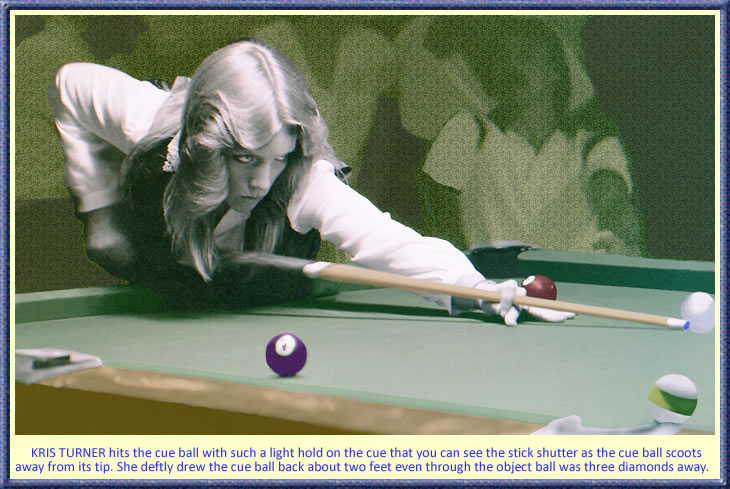
 . .
What do you get when you cross an anesthesiologist with a rabbit?
(answer)
.....Pool Pointer Archives.....
... .1. Closed Half-Bridge
... .2. Look Before You Leap
.....3. Mechanically Inclined
.....4. Keep A Level Cue
.....5. Double or Nothing
.....6. Chalk It Up
.....7. V-Bridge It To Victory
.....8. The Right Combination
.....9. Referees; Unsung heros
...10. Don't Lag Behind
...11. Tongue Twister; Mouth Pool
...12. Need Help In Reading The Right Angle?
...13. Don't Let Your Draw Stroke Be a Drawback
.....Tune
in for more Pointer articles coming
your way each month.

|

